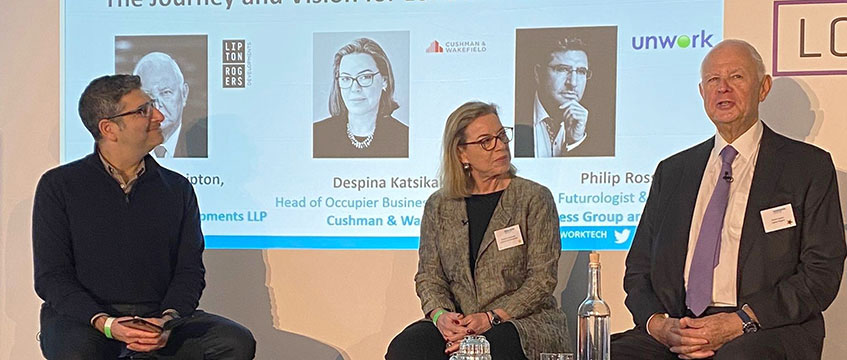A “significant disconnect” is emerging between employers and employees in the great return to work, and the real estate sector should step in to ease tensions. That was the message from Cushman & Wakefield’s head of occupier business performance, Despina Katsikakis, at Worktech’s smart buildings conference at 22 Bishopsgate – the City of London’s tallest building – last week.
Katsikakis (pictured above, centre) said mounting evidence suggests some senior leadership teams, especially at large corporates, are starting to push back on flexible working in favour of the “factory farming” days of the past. But with swathes of employees looking for a less rigid approach to how and where they work, she warned that talent retention could prove problematic for companies that don’t deliver the right environment and set-up.
“From a commercial developer point of view, if you take the perspective of the occupier, it is first and foremost about engaging, attracting and inspiring talent to do their best work,” she said. “Today, achieving this is much more challenging as tenant demands are not just about what people and employees want in the office. They are about what is needed to persuade those employees to return to the office in the first place. To enable hybrid working, a significant mindset shift and behavioural change will need happen across organisations.”
Break the mould
Katsikakis isn’t the only person who believes the onus is on employers rather than employees to recalibrate their expectations of working trends. Also speaking at the Worktech event was the man behind 22 Bishopsgate, Lipton Rogers’ Sir Stuart Lipton. He agreed with Katsikakis that companies enforcing an old way of working will be at risk of losing talent, adding that there are other ways to bring people happily and willingly back to offices.
Lipton (pictured above, right) said the real estate sector should take responsibility for showing corporate occupiers what can be done within buildings to create spaces where people want to be. “In property, too often the status quo is considered to be the future. Why is that? We have to break the mould and bring society into a built environment that makes them feel aspirational, uplifted and happy.”
Lipton and Katsikakis’s thoughts were echoed at MIPIM this week, where architects, office developers and tech firms alike agreed that creating the right spaces was the key to bringing people back to offices and that enforcing old work habits was not the answer. “Life and work have become so intertwined over the past two years,” said James Lowery, UK and Europe chief executive at essensys. “To unpick that could be detrimental, especially when the war for talent is so tough. Maintaining and retaining that talent should be a top priority.”
Speaking from the corporate occupier perspective, Melanie Williams, head of global real estate at law firm DWF, said it was more apparent than ever that things needed to change. “We are finding that the war for talent is just so tough in professional services, so we have to be very understanding. We have lost a lot of loyalty because people have been at home for so long they have lost that team spirit. It is a very complicated issue with a lot of psychology involved.”
Focus on FOMO
The good news is that steps forward can be made, and they all come down to focusing on space over policy. “We have 50-75% of our staff back now, and that is entirely down to staff making their own choices,” said Bradley Baker, chief executive of developer Co-Re London. “We haven’t pushed anyone, but we have an interesting building that people enjoy coming to. That makes a huge difference.”
“Offices need to give people a sense of FOMO – fear of missing out,” added Stephanie Crombie, an architect at Morrow + Lorraine. “You need an amazing space, much less office-looking and much more hotel-looking. This is what occupiers that know what they need to deliver want, and they are prepared to pay for it.”
And for those still hell-bent on bringing staff back by simply returning to the status quo? As Katsikakis points out, the old way of doing things hasn’t been the only way of doing things for quite some time, which could make this approach an even tougher sell. “Many of the trends of the past five years – wellness specification, hospitality amenities and services, smart tech interfaces – have now become basic expectations. These are the things that will inspire employees to come into the office and do their best work.”
To send feedback, e-mail emily.wright@eg.co.uk or tweet @EmilyW_9 or @EGPropertyNews











